|
"STAYING WITH GOATS THROUGHOUT THE DAY" (or "THE FOLLOWING INSTINCT") The accompanying pictures of LUCKY HIT LEYDI CASE (CASE JR) and other Lucky Hit Anatolians are provided to demonstrate aspects of "the following instinct" as seen in Case Jr's behaviors. May 15, 2018 By Erick Conard, LUCKY HIT RANCH, Leander, Texas |
||
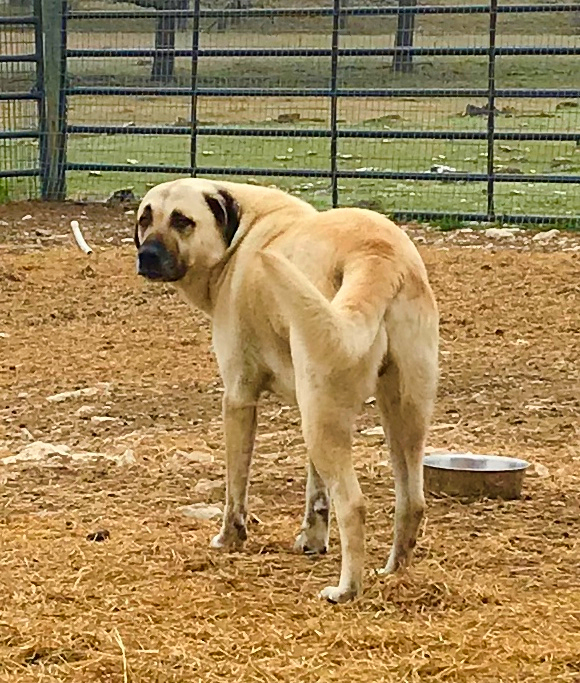 Case Jr, pictured on March 2, 2019 guarding goats and kids at Lucky Hit Ranch 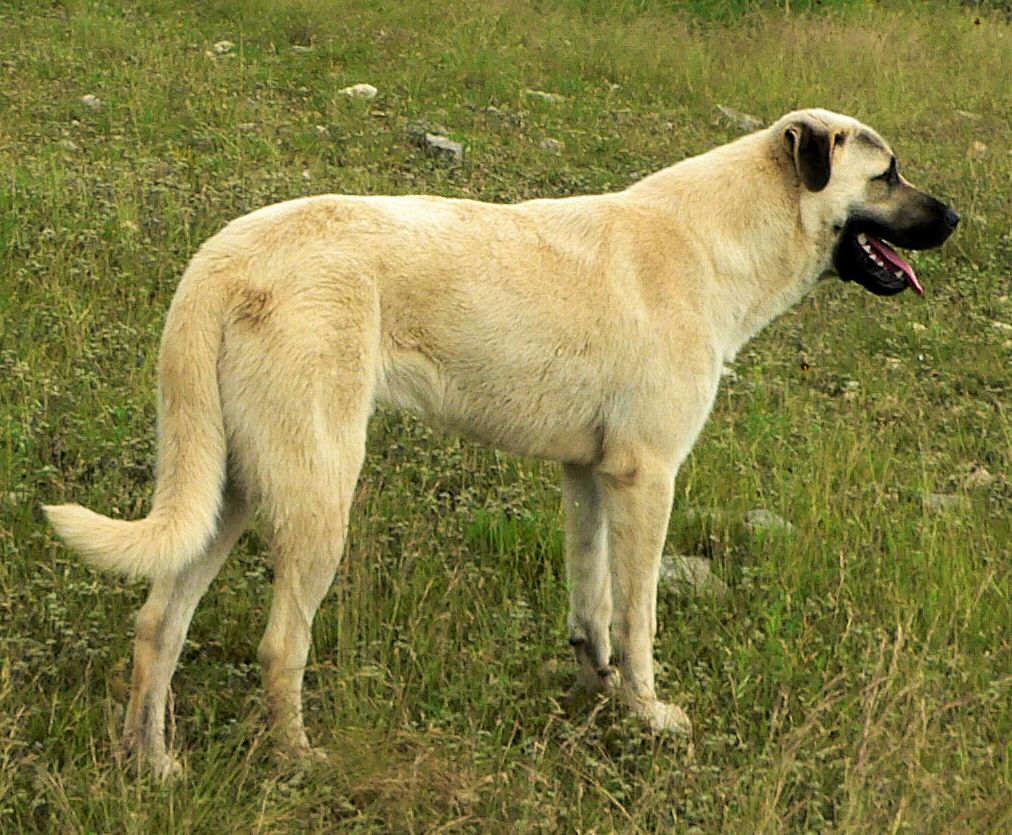 Case Jr, Male Puppy 6, pictured on 5/18/2015 when nine months old at Lucky Hit Ranch from the Kibar/Leydi August 1, 2014 litter Case Jr is a son of two proven working livestock guardians - Lucky Hit Kuvvet Kibar and Lucky Hit DivaKiz Leydi ... and Great Grandson of Lucky Hit Shadow Kasif (CASE) Case Jr was named after my beloved Lucky Hit Shadow Kasif (CASE) because as a young pup he reminded me so very much of his great grandfather, CASE. |
||
|
"THE FOLLOWING INSTINCT" 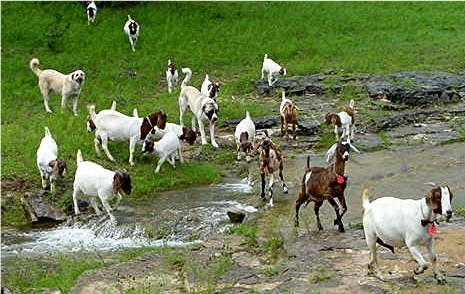 Lucky Hit Anatolians following the flock as the flock moves across the pasture
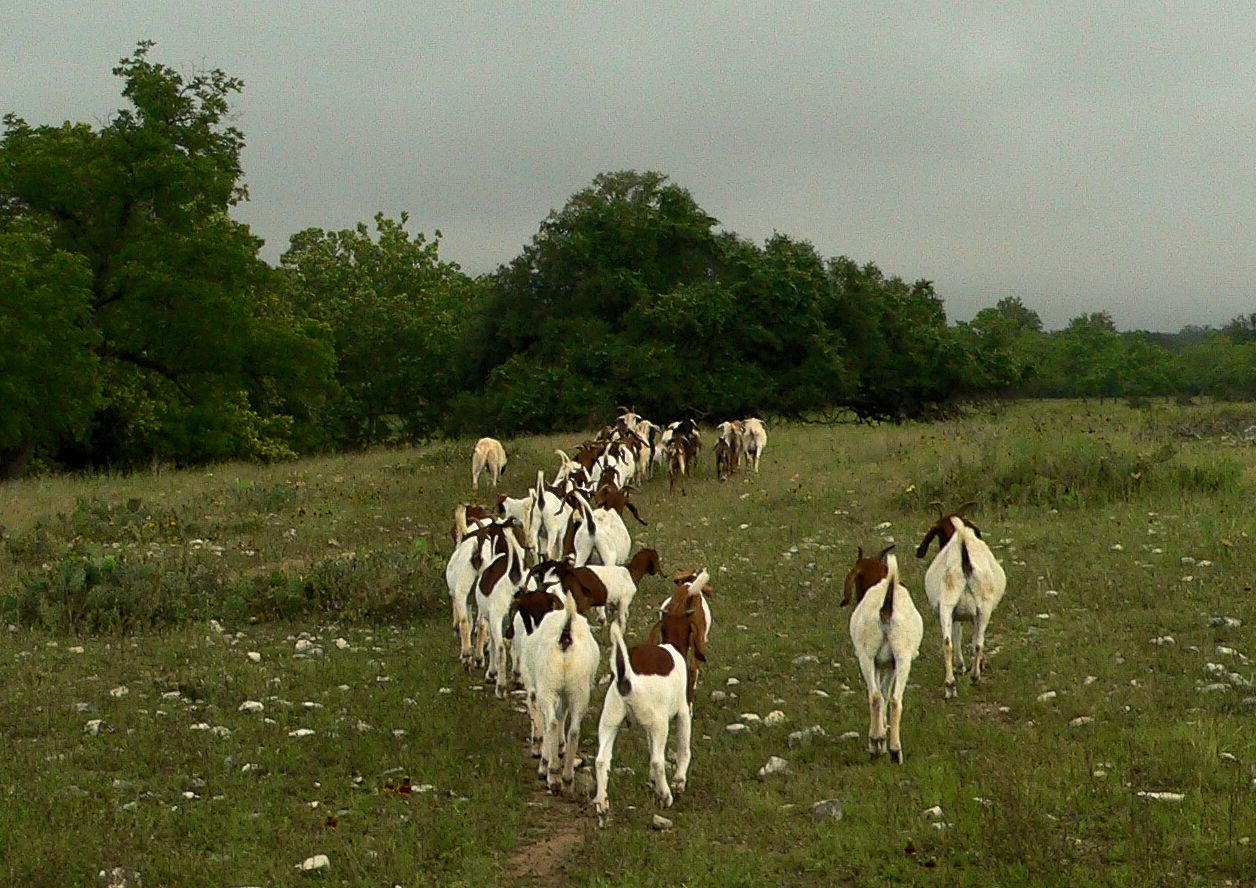 Early in the morning nine month old Case (Lucky Hit Leydi Case) follows his goats into the big pasture
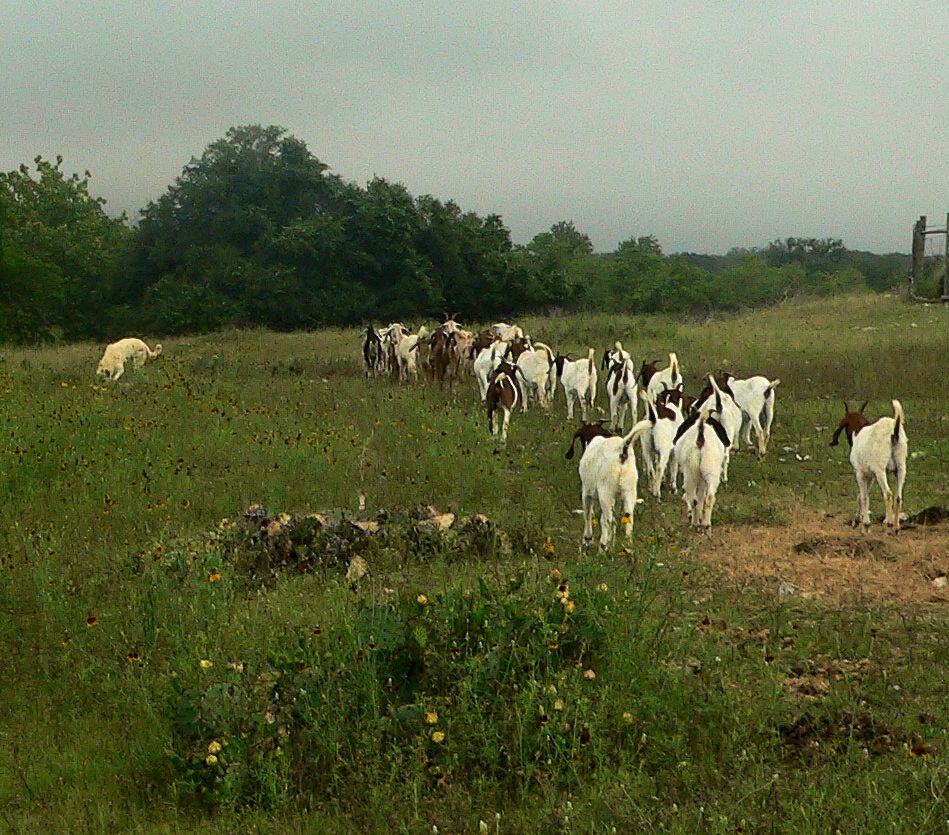 Nine month old Case (Lucky Hit Leydi Case) makes side trips to check out smells as he follows his goats into the big pasture A very important trait I look for when selecting a dog with superior following instinct is a dog that makes decisions based upon where the goats are. For example, sometimes when I let the dogs and goats out of the corral in the morning the goats aren't ready to move out and stop just outside the gate and lounge around a while. A dog with superior following instinct will have forged ahead sweeping back and forth looking for problems but when that superior dog sees that the goats aren't moving out, the dog will turn around and rejoin the flock, patiently waiting with his herd until the herd decides to move out. Even if other dogs continue to move across the pasture, leaving the flock, the dog with superior following instinct will rejoin his flock. When the goats finally move out, the superior dog will then eagerly move out ahead of the flock, sweeping back and forth again to check for unexpected problems. Sadly, since most breeders aren't set up to check for working ability to this degree, this wonderful and now rare trait, which must be genetic and cannot be learned, may be lost from the breed. I am so thankful to have Lucky Hit Leydi Case (Case Jr) because he possesses this ability to the highest degree I have ever seen. Perhaps because for the last 30 years I have placed working ability as my highest selection criteria! To maintin good working ability in the breed, all breeding stock must be selected for working ability with sheep and/or goats in a predator rich environment. Selecting for traits frequently found in a generic AKC show dog generally decreses working ability over time!!!!  Nine month old Case (Lucky Hit Leydi Case) on the left and six month old Cedar Rise Tupelo Honey of Lucky Hit (Tupe) on the right following their goats into the big pasture Note the difference in tail carriage. Case, on the left, has his tail low. He has stopped and is checking that the entire herd continues to follow him. Case's tail carriage signals that all is clear. Tupe, on the right, has his tail level and his nose down checking out the smells as he is trots forward. Tupe is signaling that as they move across territory he is watchful but senses nothing of concern. This relaxed tail carriage is what I want to see in the ring, where the dog is moving in new territory but isn't alarmed or on the defensive. I have had dogs that held their tails up in the ring, and while the tail up position looks pretty, it concerns me to have an off territory Anatolian (in the ring) who should signal that all is well and no trouble is expected but instead signals full alert by carrying an upright tail! Good breeders who care about working behavior notice tail carriage and consider it as an important factor when selecting breeding Anatolians. Tail carriage is a major factor in the dogs communication with their herd! 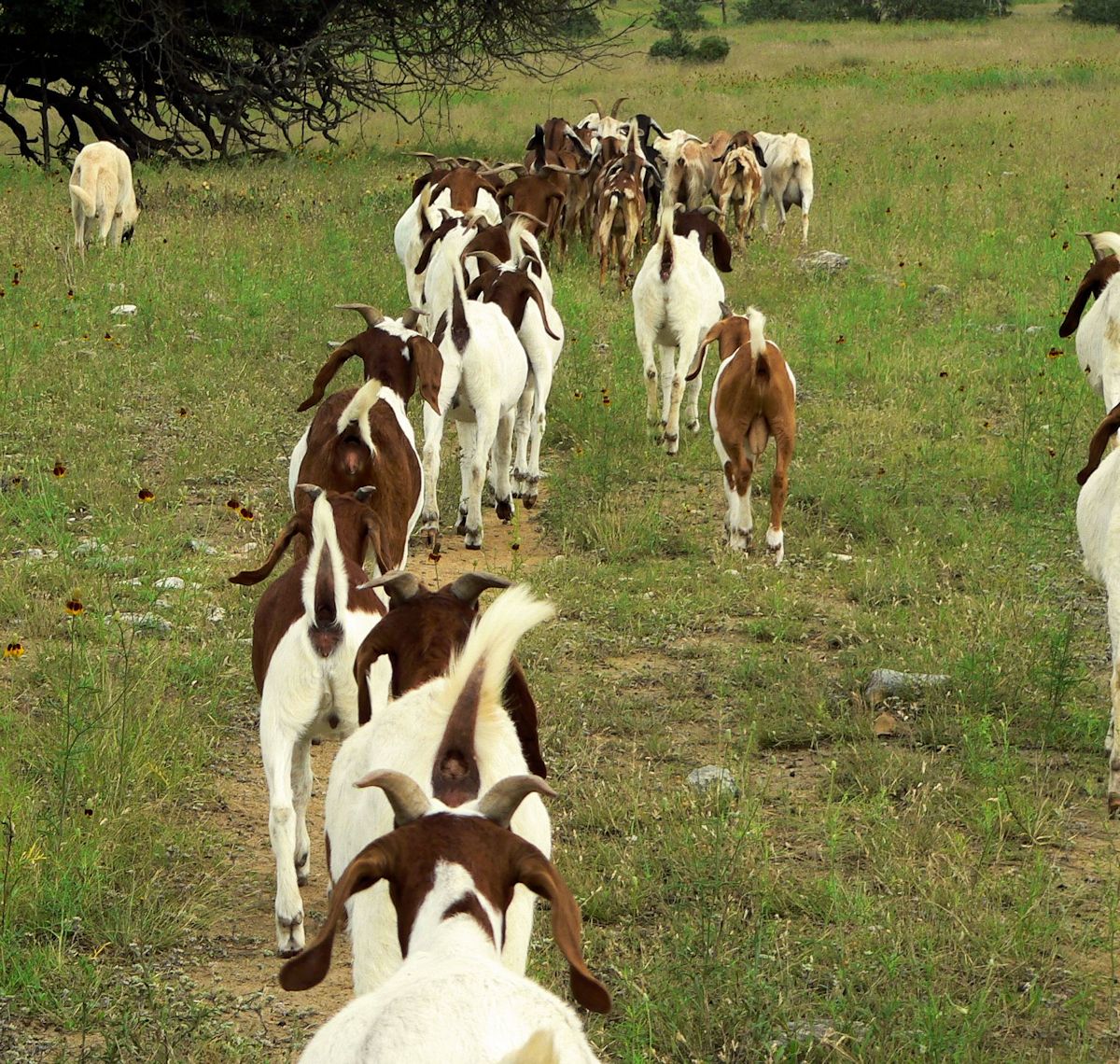 Nine month old Case (Lucky Hit Leydi Case) following his goats into the big pasture Another example of superior following instinct from Lucky Hit Leydi Case (Case Jr) when he was 10 months old happened only a couple of minutes after I'd released the goats and dogs from the corral. A squirrel ran in front of the dogs and dashed into a large bush just outside the fence. All three pasture dogs took off after the squirrel and were leaping up trying to catch him. The squirrel was chittering and lecturing the dogs loudly, enticing them to even more action. As this was happening, the goats continued moving out into the pasture. The only dog that seemed to notice the goats were leaving was Case Jr, who twice turned to run after them only to turn back as the other two dogs barked with renewed enthusiam. The third time Case Jr whirled to run to the goats, then hesitated, I simply pointed to the goats and said, "Case, Go to the goats!" And Case Jr immediately took out at a dead run and rejoined his goats at his customary place in front of the herd! It is important to have a guardian dog who is willing to leave behind a potential threat that has been neutralized in order to stay with the herd. After all, a new and perhaps even more dangerous threat might appear!!! Again, it is my experience that this type of behavior cannot be taught but must be a part of the genetic make-up of the dog. Therefore, truly good working behavior can only be maintained in lines that use working ability as their primary breeding selection criterion. While conformation is important in good working dogs, without the correct working behaviors you do not have a true Anatolian guardian dog! 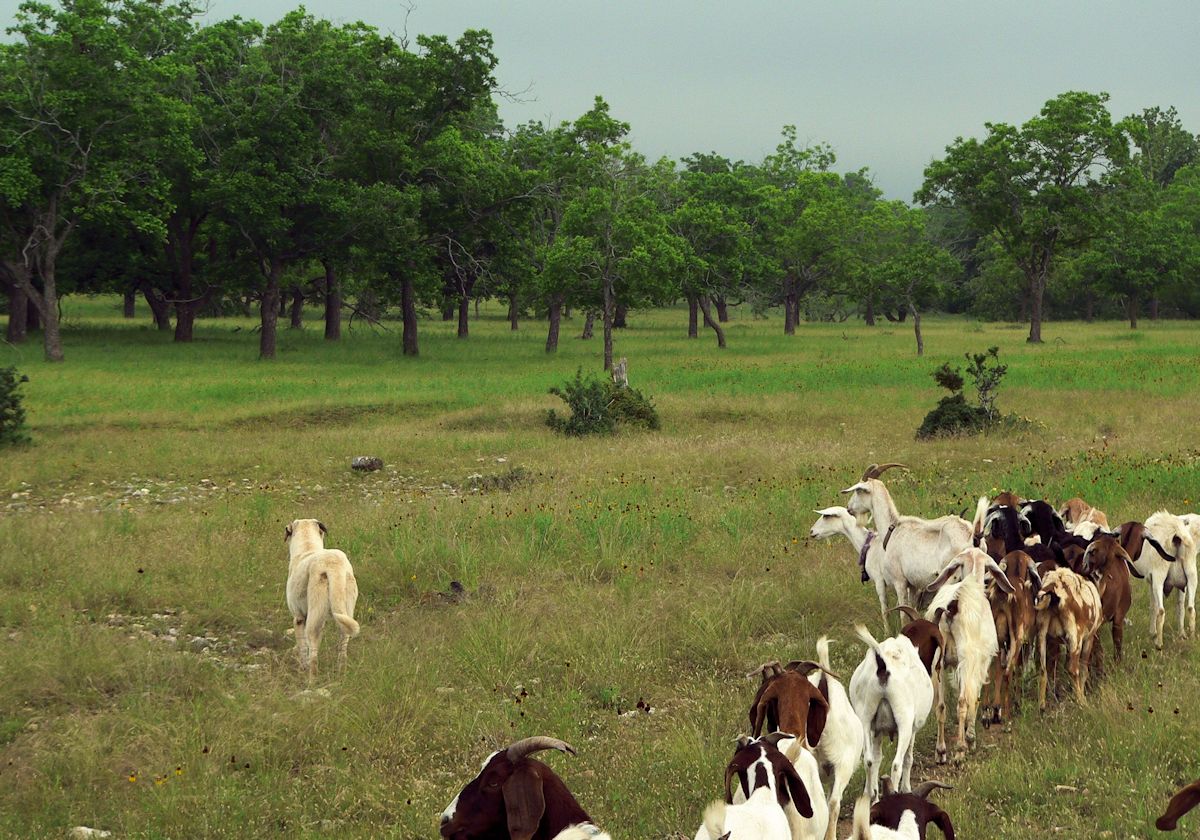 Nine month old Case (Lucky Hit Leydi Case) on the left following his goats into the big pasture 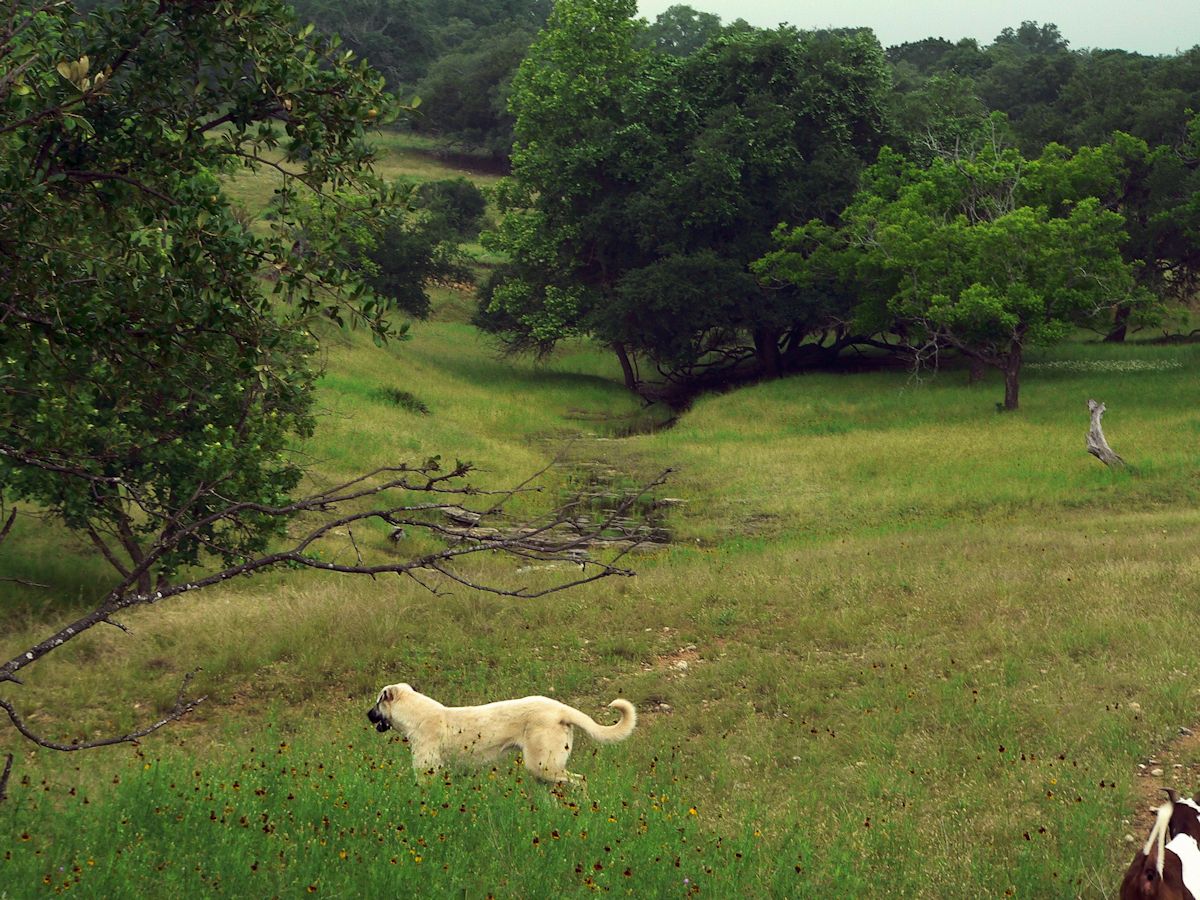 Nine month old Case (Lucky Hit Leydi Case) decides to check out something near the spring Note that Case has moved his tail position up a bit... He has seen nothing that alarms him yet, but is moving toward an area he hasn't check out. 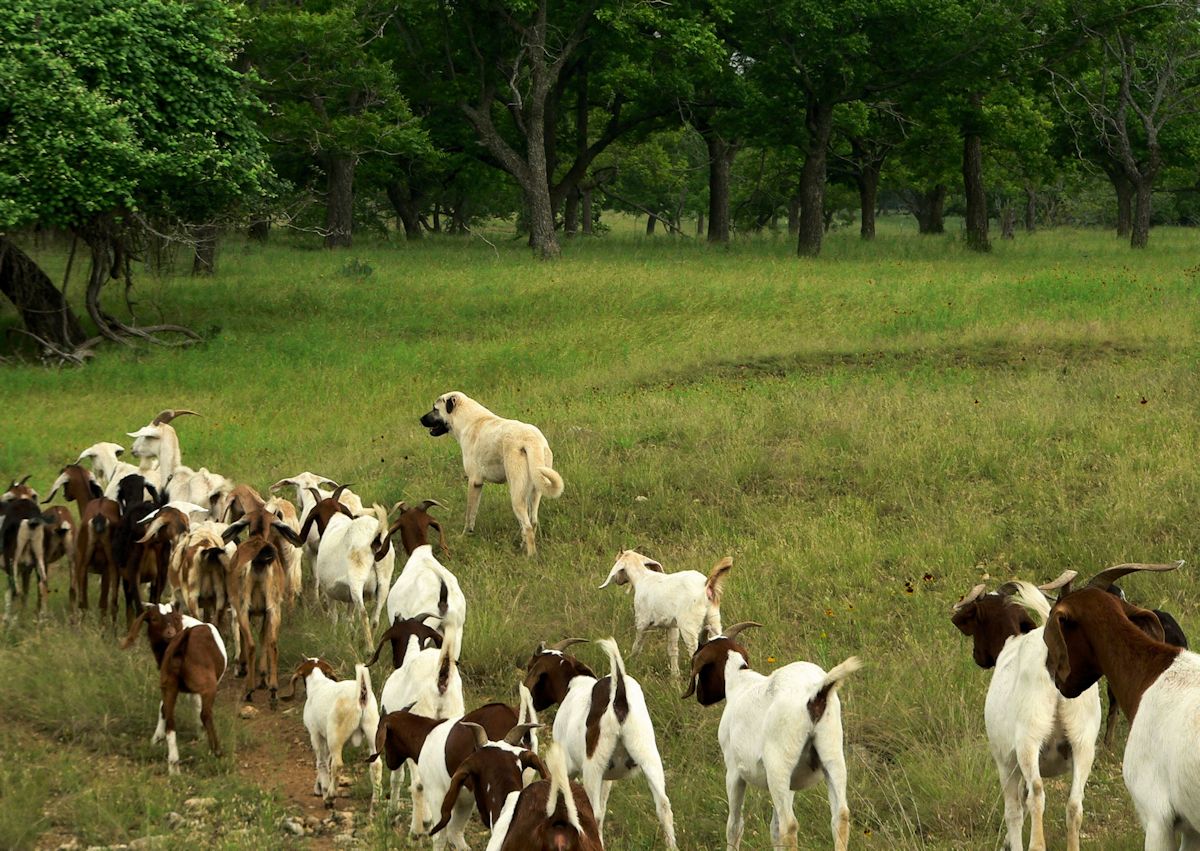 Nine month old Case (Lucky Hit Leydi Case) returns to his forward position with the goats 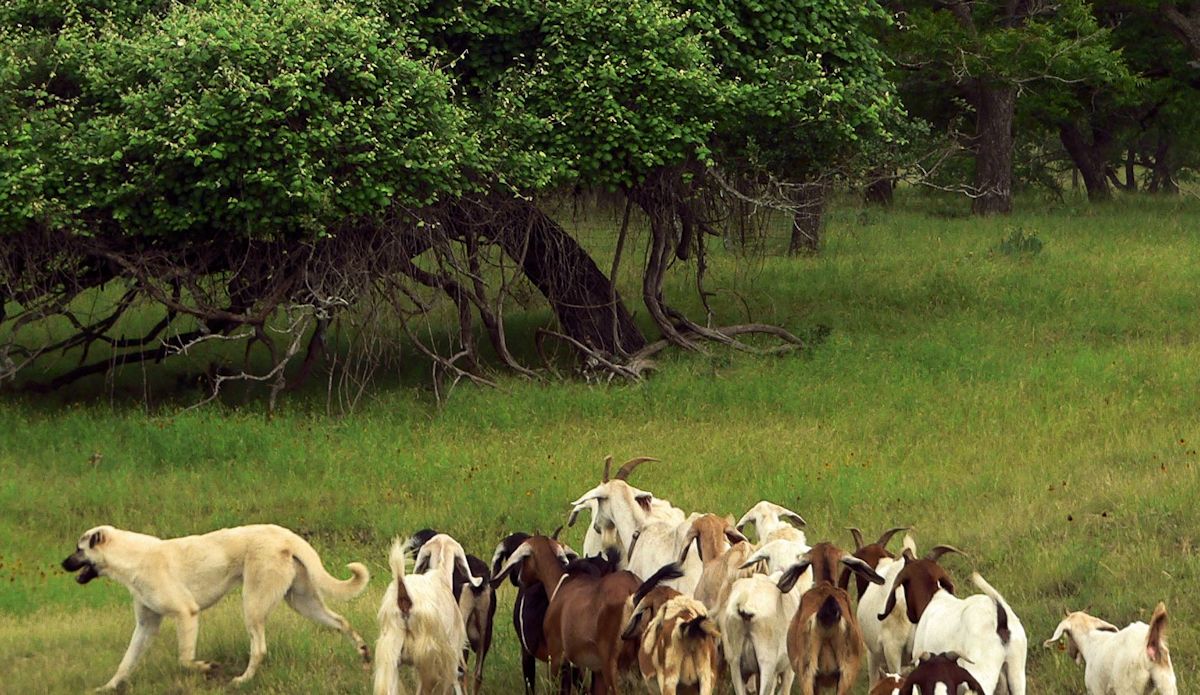 Nine month old Case (Lucky Hit Leydi Case) moves to the spring for a quick drink 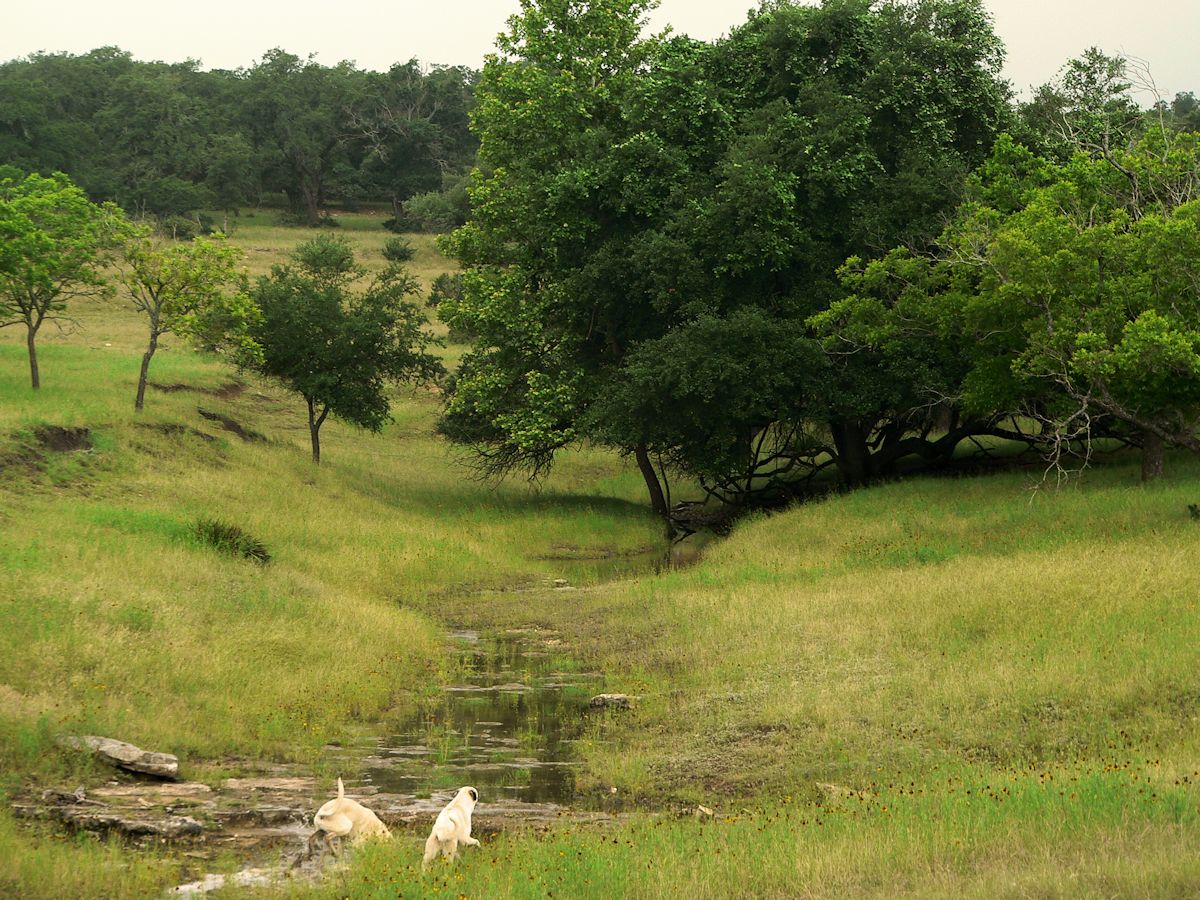 Six month old Cedar Rise Tupelo Honey of Lucky Hit (Tupe) on the left and nine month old Case (Lucky Hit Leydi Case) on the right protecting their goats in the big pasture The goats are moving along to the right of the stream and the pups decided to take a quick water break! Cedar Rise Tupelo Honey (TUPE) is a Male Puppy from Cedar Rise Anatolian's Yaman/Rana 11/8/2014 litter 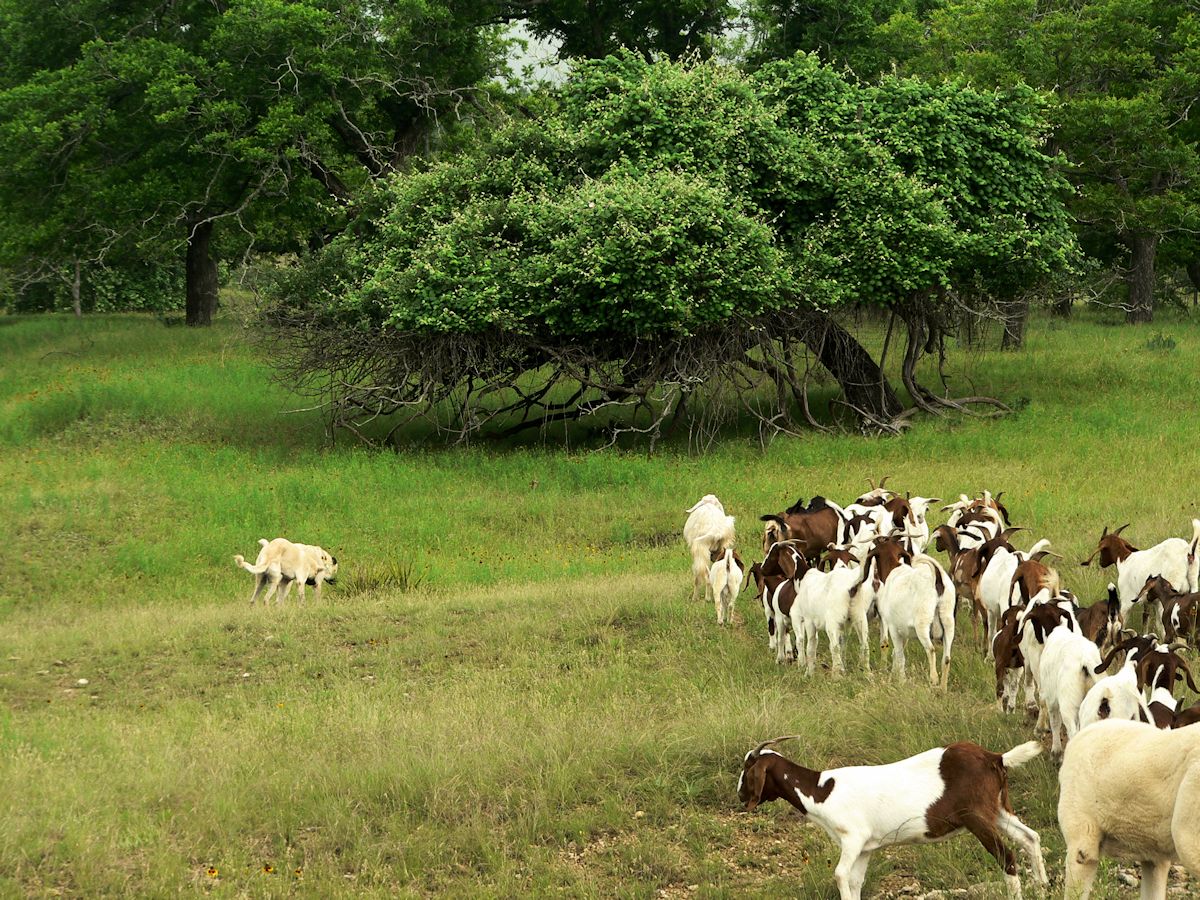 Nine month old Case (Lucky Hit Leydi Case) returns to the goats after his quick trip to the adjacent spring 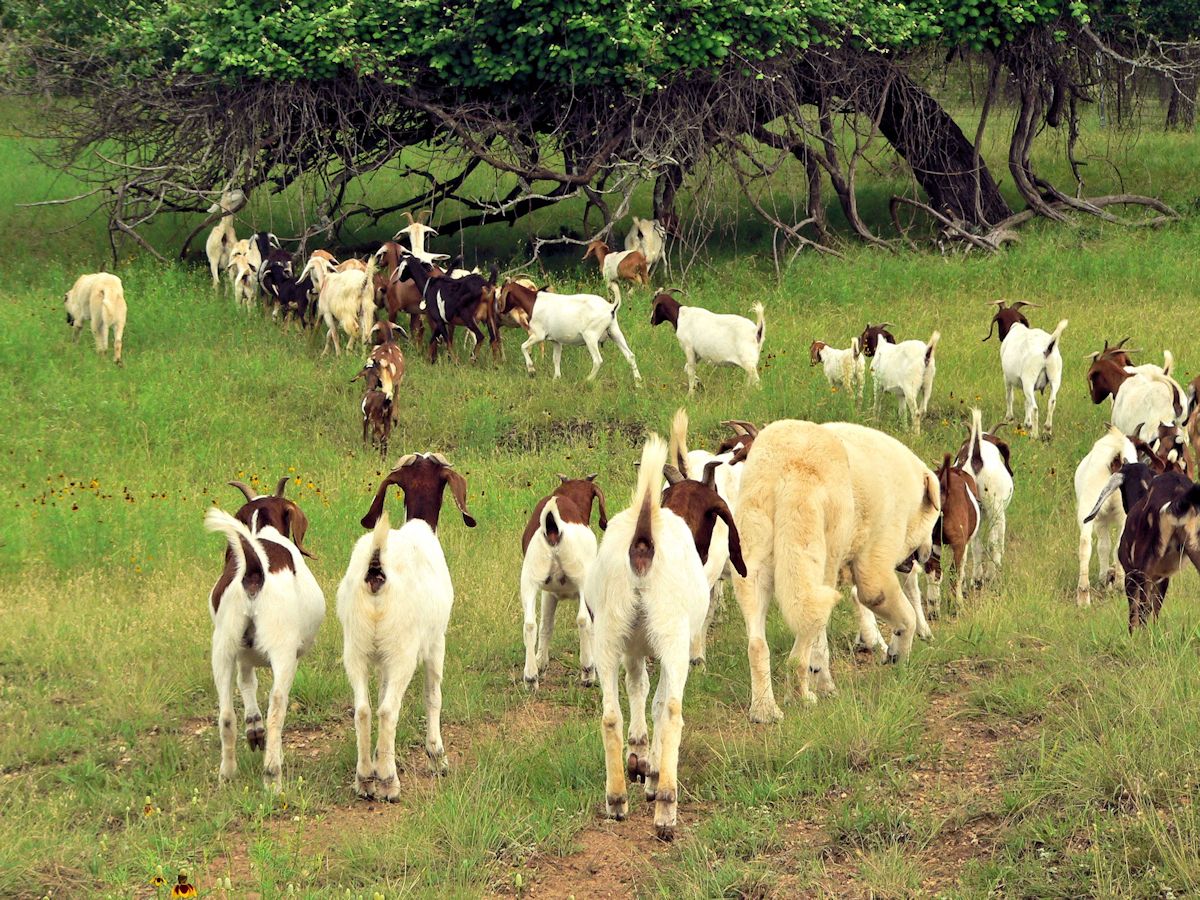 Nine month old Case (Lucky Hit Leydi Case) continues moving through the pasture. As usual, Case Jr is not only accompanied by Cedar Rise Tupelo Honey (TUPE) but also two almost nine year old dogs, Champion Lucky Hit Shadow Zirva (seen following the goats in this picture) and Lucky Hit Sahara Benek, who is bring up the very rear. I am thrilled to have produced a male like Zirva who has no trouble getting along with either the six month old male, Tupe, or the nine month old male, Case Jr. It also speaks well of the two young males that they are more interested in protecting the herd than fighting an older dog that is clearly NOT a threat to the herd! This doesn't mean they can be together always! 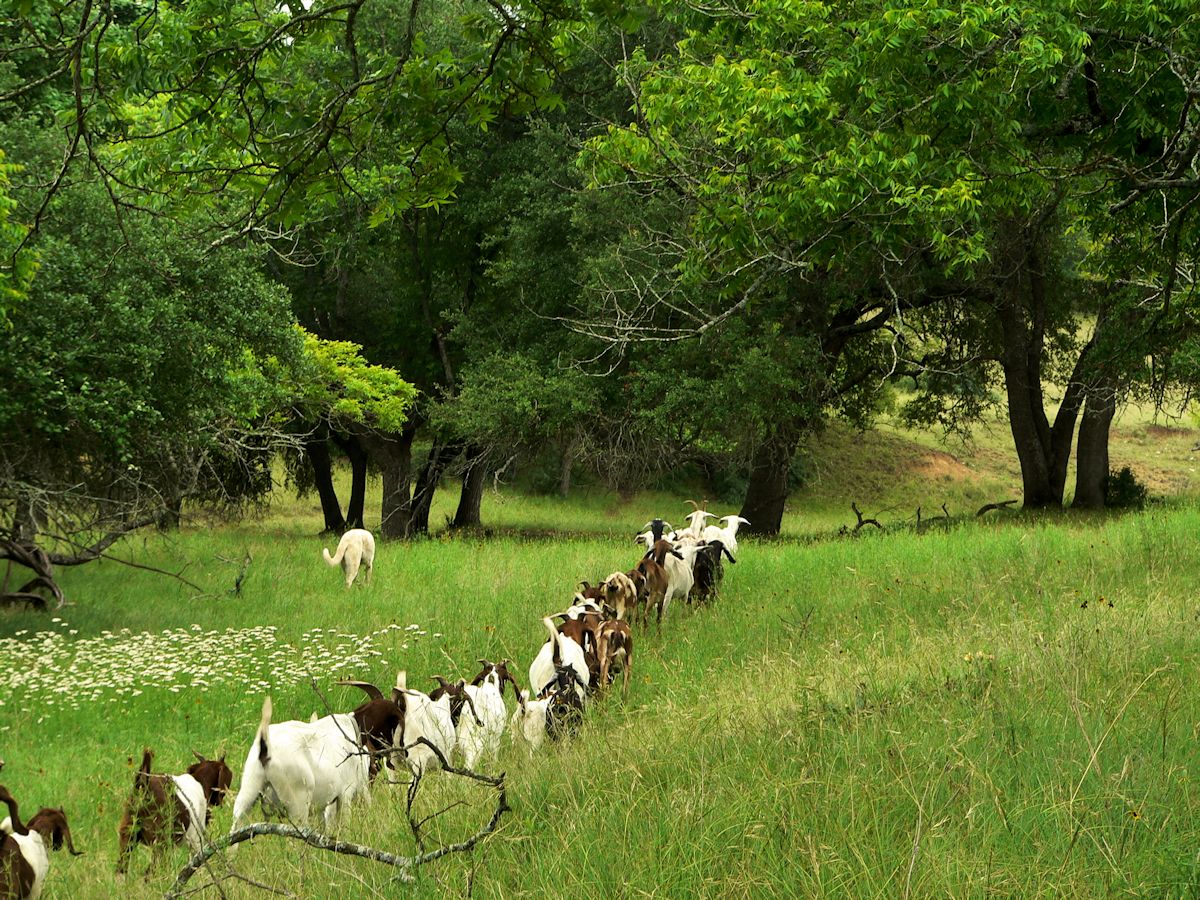 Nine month old Case (Lucky Hit Leydi Case) near the front of the line as his goats moves into the pasture  Nine month old Case (Lucky Hit Leydi Case) checks out the underbrush as Cedar Rise Tupelo Honey of Lucky Hit (Tupe) (almost off the left side) checks something he spotted there See how high he now has his tail... That indicates he's concerned about whatever he is checking out. 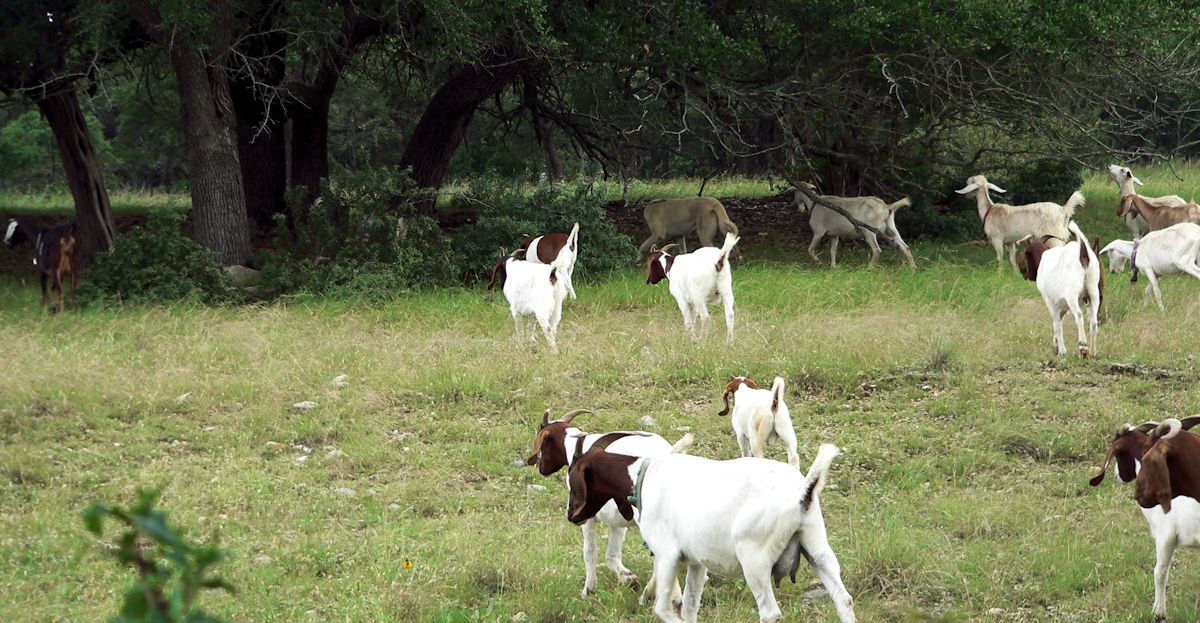 Nine month old Case (Lucky Hit Leydi Case) keeps near the front of the goat herd and continuously checks everything for danger. 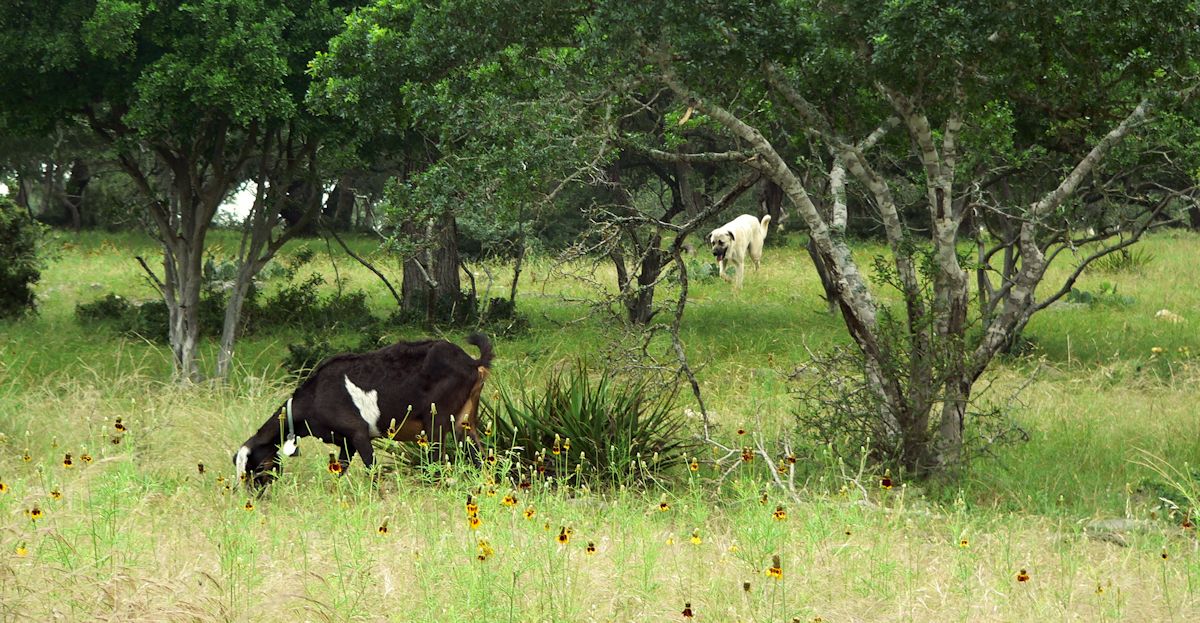 Nine month old Case (Lucky Hit Leydi Case) moves more quickly and aggressively through the trees than when the goats were more in the open. The good working Anatolian makes many side trips to check out nearby smells or sounds and then returns to the herd, as Case Jr is doing, keeping protection where it needs to be... with the herd. A good guardian trots back and forth across the front of the herd as the herd moves across territory. This activity goes on for as long as the goats are moving... which is pretty much the entire day. As they get older, Anatolians spot high areas to watch their goats while they rest. But when the goats move on they have to get up and trot onward. For an Anatolian to move so continuously, the Anatolian must have perfect working conformation. Without perfect working conformation, their bodies would not be able to sustain this level of exercise long. 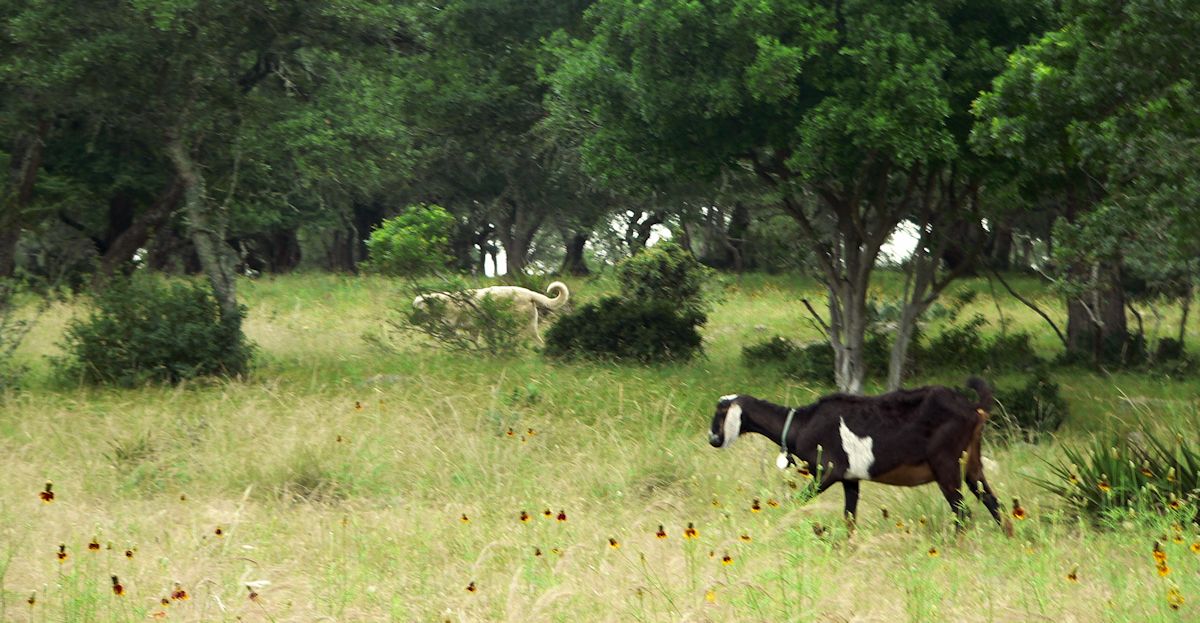 Nine month old Case (Lucky Hit Leydi Case) having returned to the herd, moves forward in whatever direction the herd is moving. Only when one of my Anatolians believes that serious danger is nearby will that Anatolian direct the herd's movement. The Anatolian usually accomplishes this by running in two or three circles around the herd at high speed with tail up and waving back and forth quickly and aggressively. This activity causes my goats to bunch and when the Anatolian moves out the goats follow... generally in the direction of the barn. I have more dogs there and I believe that gives the Anatolian a greater sense of security! 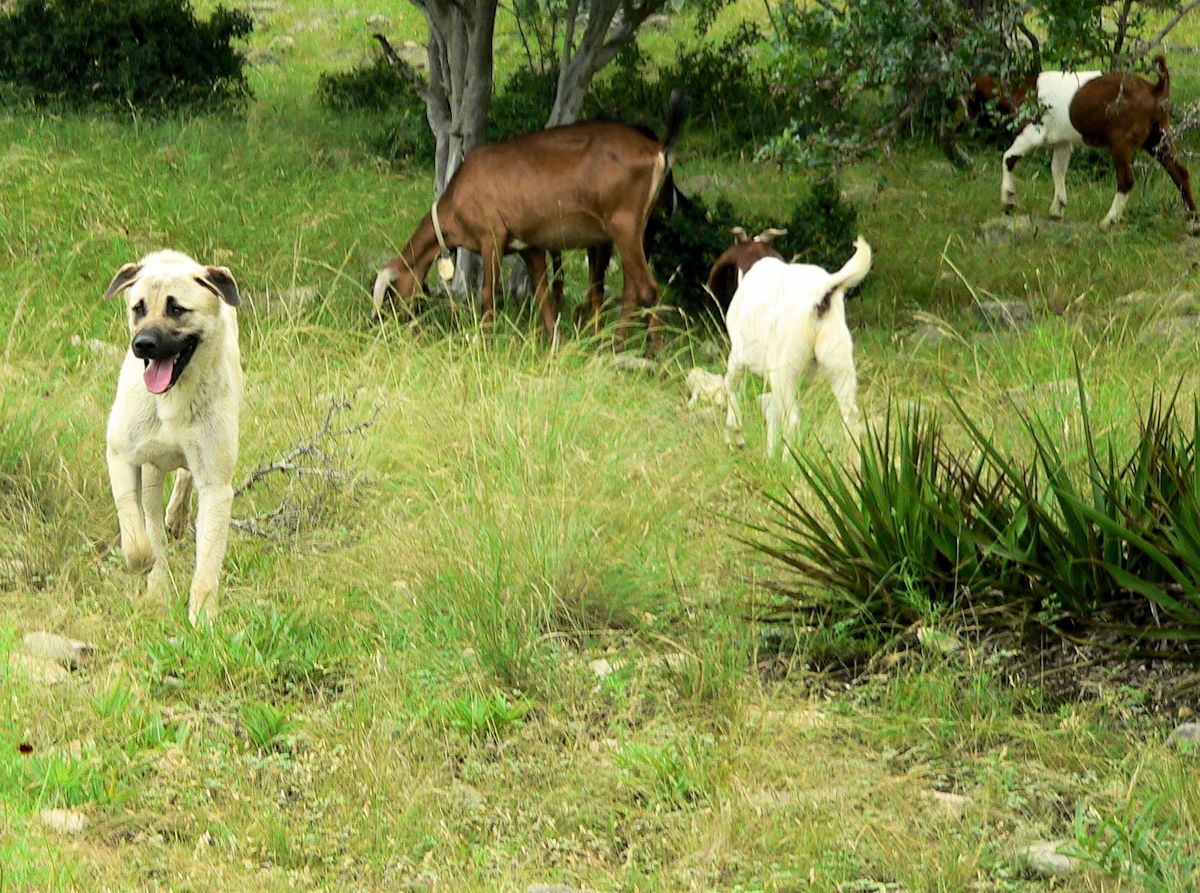 Nine month old Case (Lucky Hit Leydi Case) trots quickly to check out something that concerned him. When a good working Anatolian moves into new territory, the Anatolian compulsively and continuously checks every odd sight or sound. The good working Anatolian wants their herd to be safe and won't tolerate any danger near them. 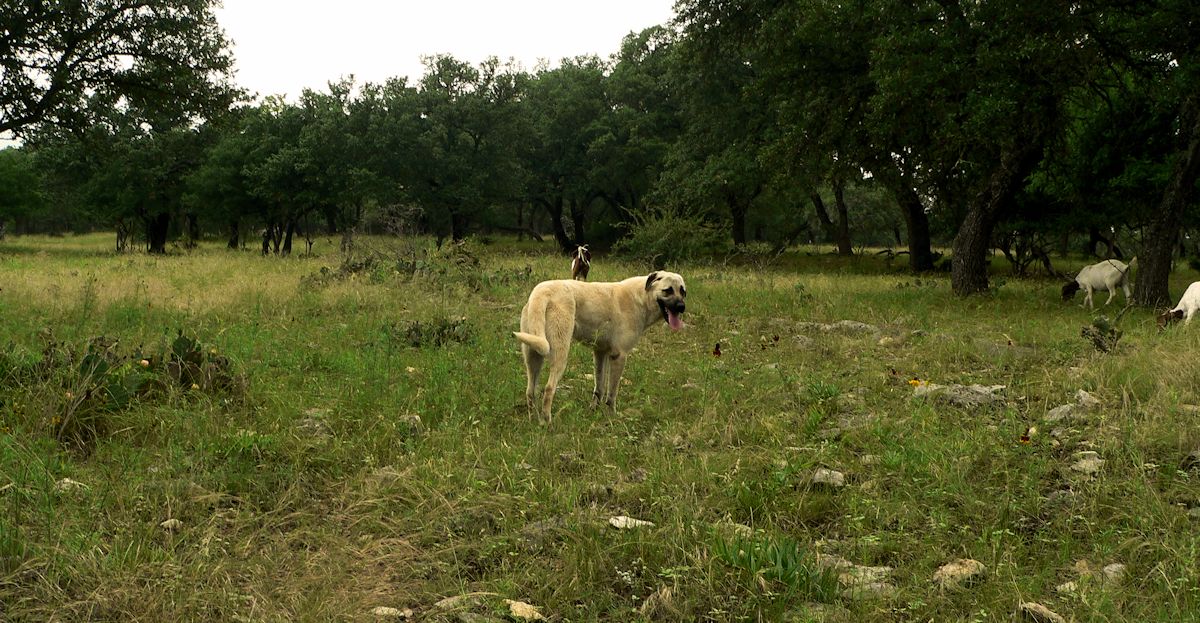 Nine month old Case (Lucky Hit Leydi Case) stops to check on the herd progress (and in this case, my progress). A really important sign of a good working Anatolian is one that clearly loves working. Case Jr loves working! This thrills me! 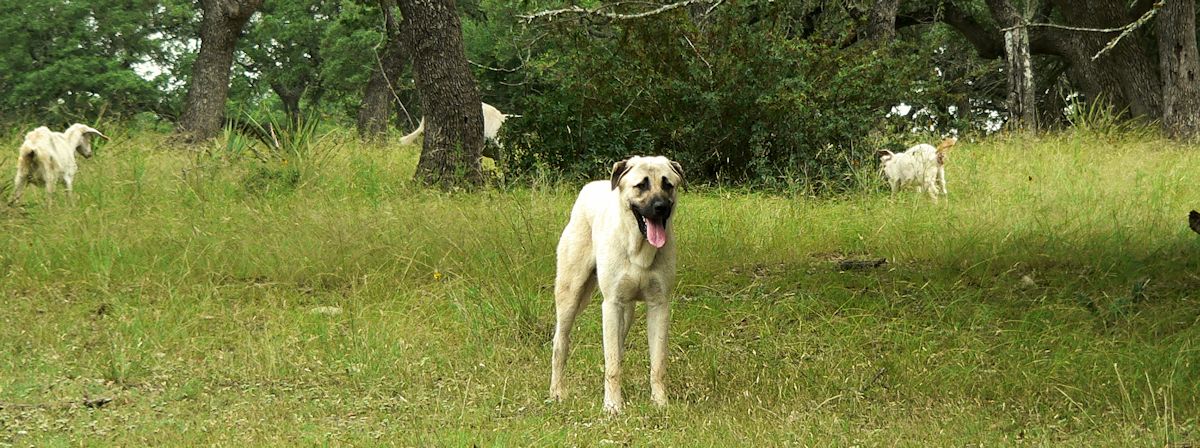 Nine month old Case (Lucky Hit Leydi Case) keeps a sharp eye out for predators. Besides his excellent working ability you can see his beautifully athletic body. 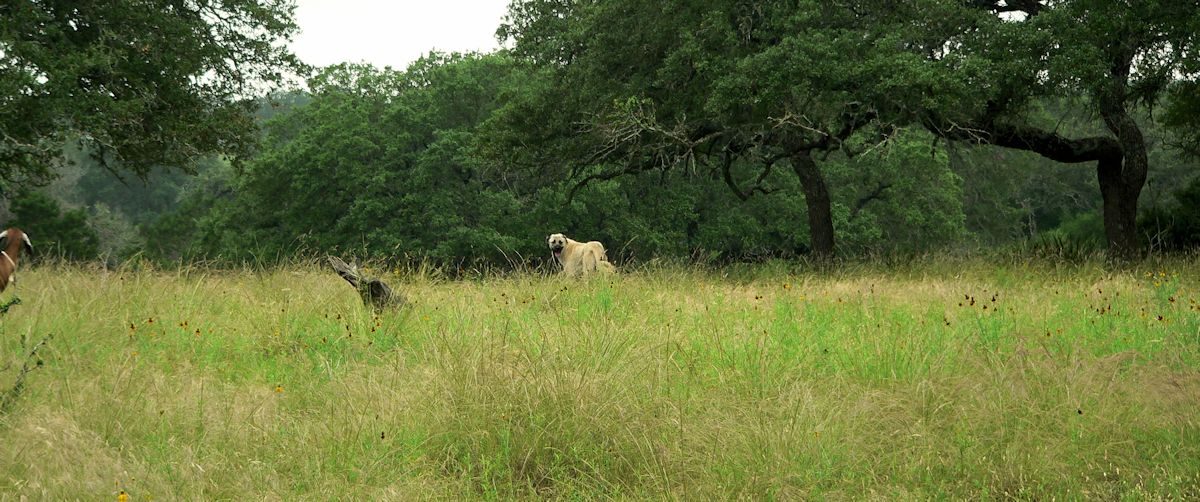 Nine month old Case (Lucky Hit Leydi Case) looks back toward the herd as the herd moves forward through the pasture. 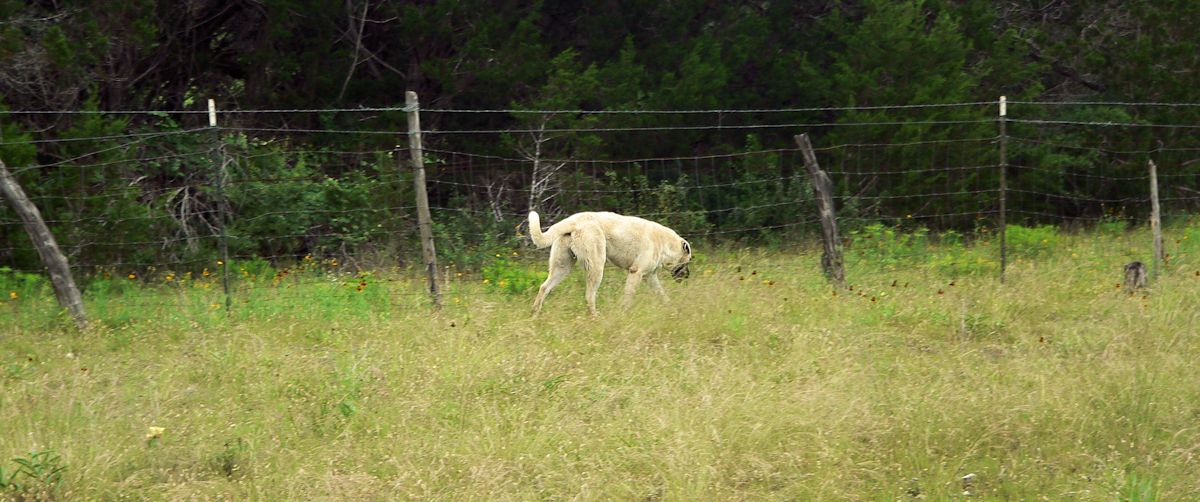 Nine month old Case (Lucky Hit Leydi Case) carefully checks the fenceline to determine what animals have been visiting his pasture.  Nine month old Case (Lucky Hit Leydi Case) and his buddy, Tupe, re-join Zirva and Benek as the herd turns back toward the barn. While both older dogs (Zirva and Benek) have been following the herd, they have trailed behind and rested under trees with a good view of the herd, only moving forward when the herd has moved almost out of their view. This way they don't have to cover as much territory and still protect their charges. Most older Anatolians tend to follow in this more distant energy saving manner. Also, once the herd and the Anatolians have covered the entire pasture at least once, the Anatolians might return to the barn area for the afternoon. Since I only have fifty acres, my Anatolians feel certain that they can still reach the goats in time if a predator appears. The rule I use to determine if an Anatolian is protecting effectively is this... Have I lost any animals? If all animals are safe I know my Anatolians are effectively protecting my herd.  Nine month old Case (Lucky Hit Leydi Case) and his buddy, Tupe, re-join Zirva and Benek .  Nine month old Case (Lucky Hit Leydi Case) and his buddy, Tupe, once again move forward to check out territory toward which the herd is moving. You can see that Tupe smells something exciting and his tail is up as he follows the trail. Tail up in the ring indicates to me that that Anatolian, who is off territory and should be subdued with a level or lowered tail, is either signaling incorrectly (making it a less than desirable candidate as a working dog) or is far to defensive and on guard in an off territory (neutral) situation. Many show breeders press for show Anatolians to carry their tails upright in the ring. Rather than selecting for tail up in the ring, which is striking and pretty for the show, I wish show breeders would focus on correct tail position for working Anatolians and would help educate show judges so the judges would pick traits necessary to maintain good working ability in the breed. Since working Anatolians depend on their tail position as a major communication device with their herd, it is important that show breeders understand correct tail position. Otherwise, these show focused breeders will breed correct tail position out of their line. An Anatolian that works will confuse the herd if its tail up position means it is happy! 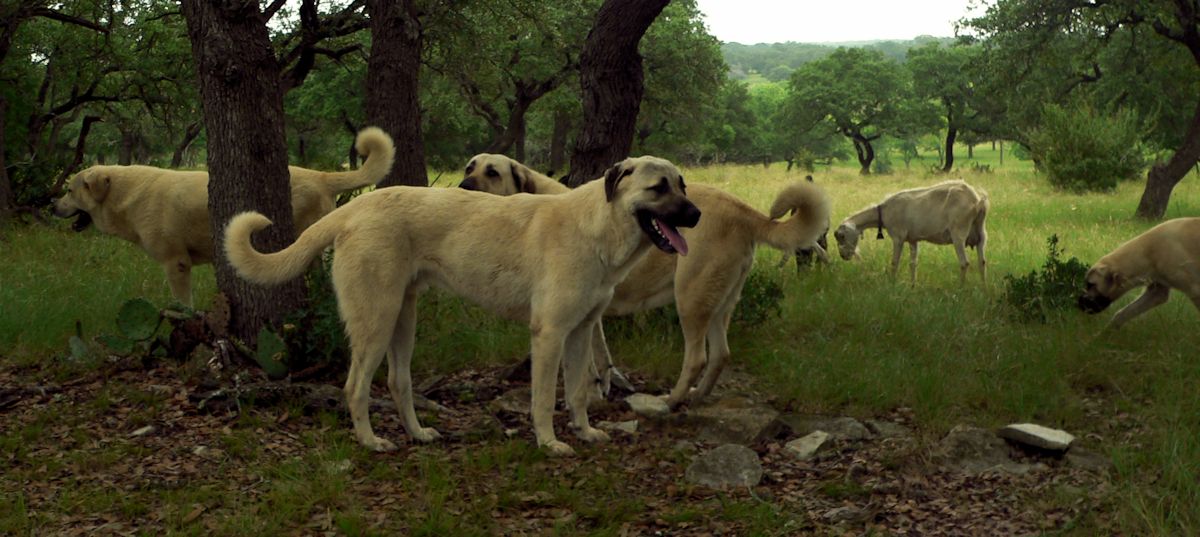 Nine month old Case (Lucky Hit Leydi Case) and his buddy, Tupe, coming in from the right side... with Zirva and Benek . Note the tail position on all the dogs. The are calm and watchful. They don't perceive any threat but are still alert. And their tail position is signaling this information to the herd. This tail position (or even lower) is what I like to see in the show ring. NOT TAIL UP! 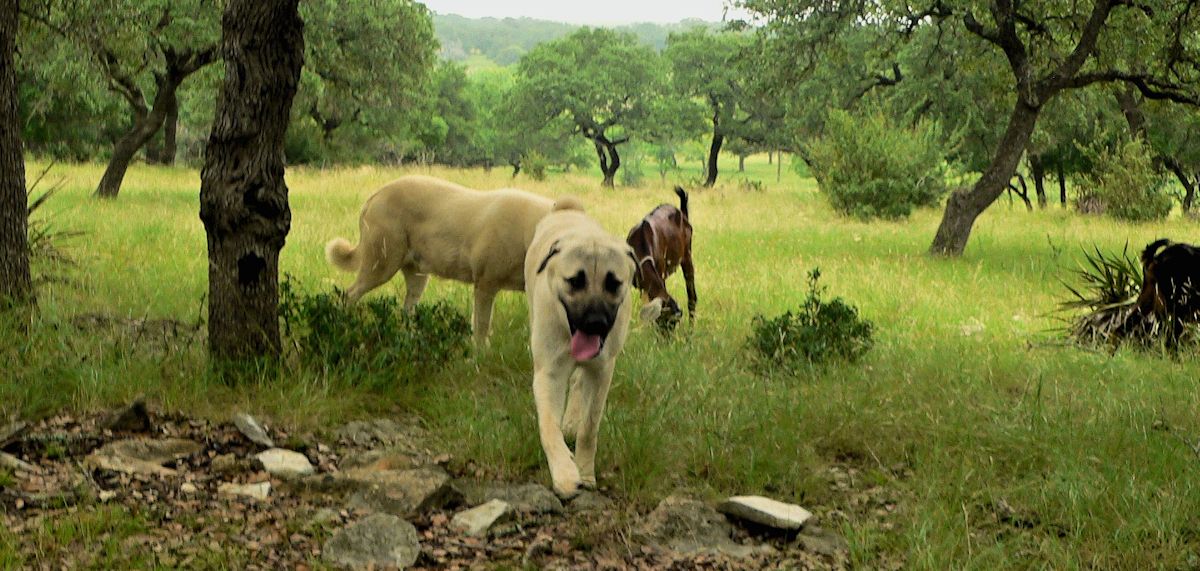 Nine month old Case (Lucky Hit Leydi Case) ... with Zirva. You can see that as Zirva (walking behind Case Jr.) moves forward his tail has dropped. Zirva satisfied himself that all is well and so now signals that belief to the herd. 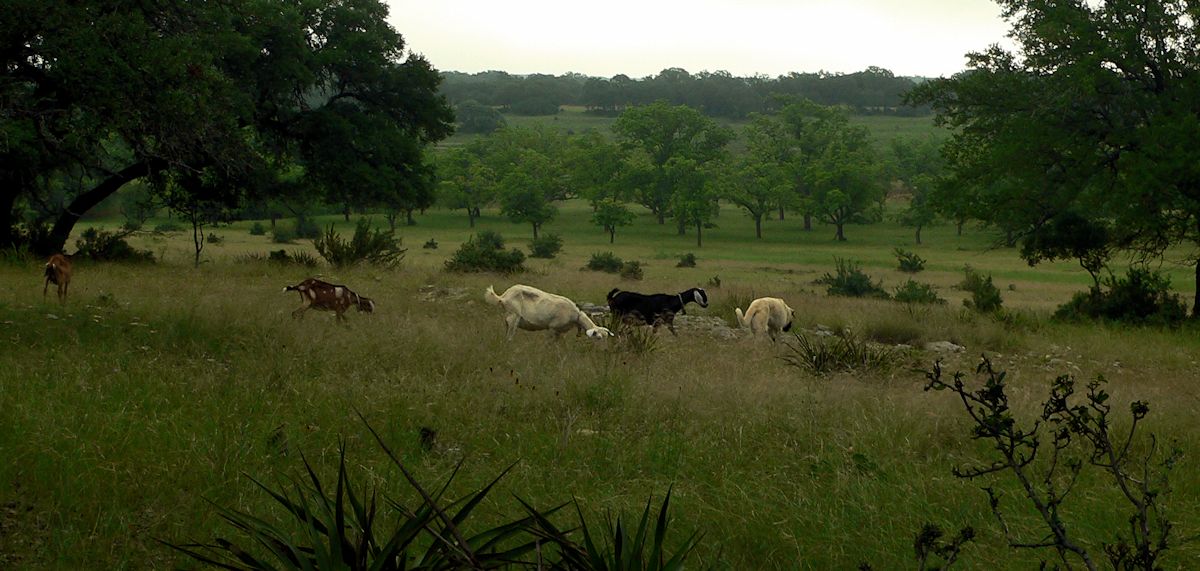 Nine month old Case (Lucky Hit Leydi Case) presses forward across the pasture. While Case Jr positions himself toward the front of the herd, he never allows himself to stray too far away even when exploring some scent. The further away he gets from the herd, the faster he returns... sometimes running back at full speed to check on the safety of his animals. 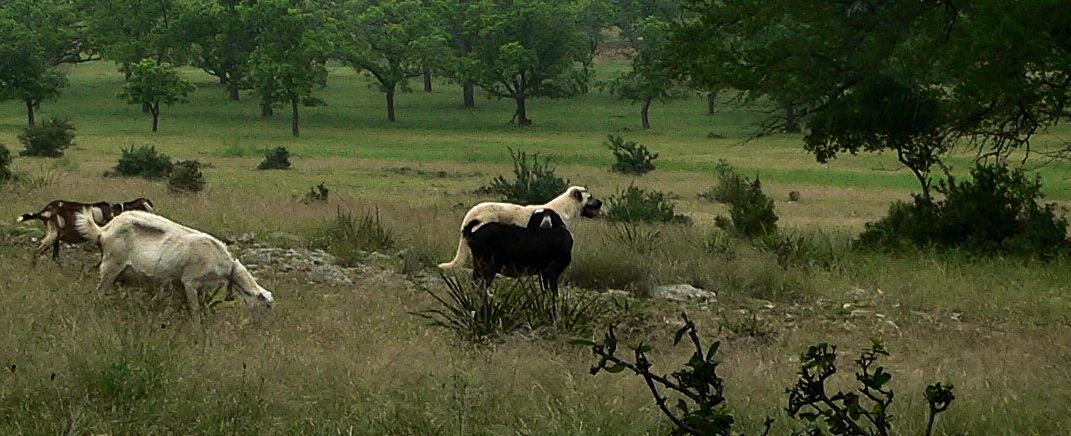 Nine month old Case (Lucky Hit Leydi Case) carefully scrutinizes the pasture ahead. 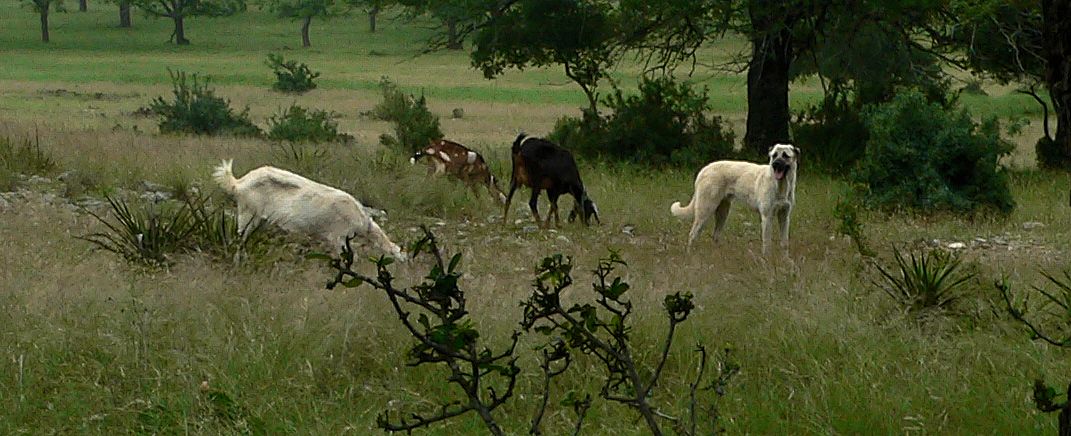 Nine month old Case (Lucky Hit Leydi Case) looks everywhere, not only check for predators but also checking the goats are following. Case Jrs athleticism and conformation are as incredible as his amazing working ability! 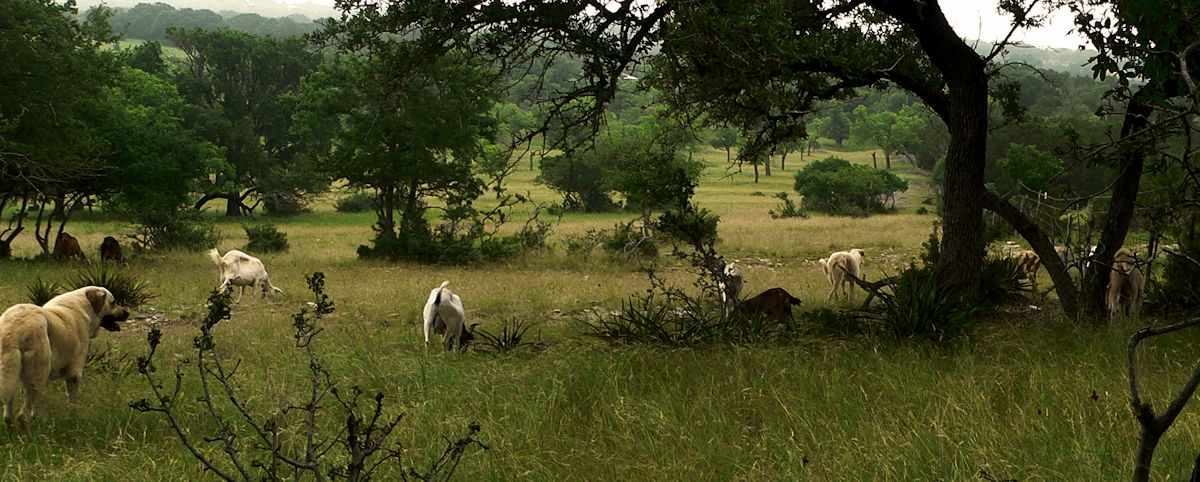 Nine month old Case (Lucky Hit Leydi Case) moves on ahead of the herd once he is satisfied all is well... still checking continuously. 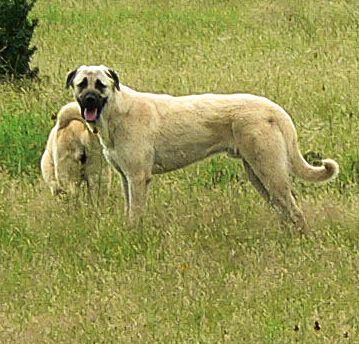 Nine month old Case (Lucky Hit Leydi Case) is one stunningly beautiful working Anatolian!!! 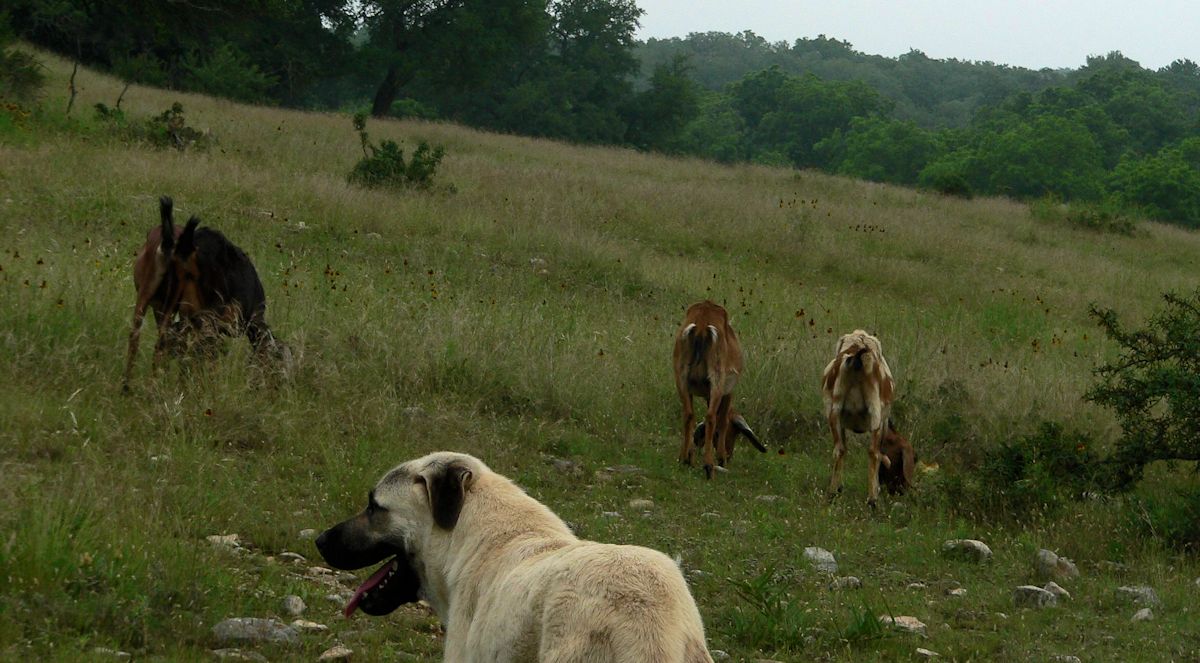 Nine month old Case (Lucky Hit Leydi Case) is one stunningly beautiful working Anatolian!!! 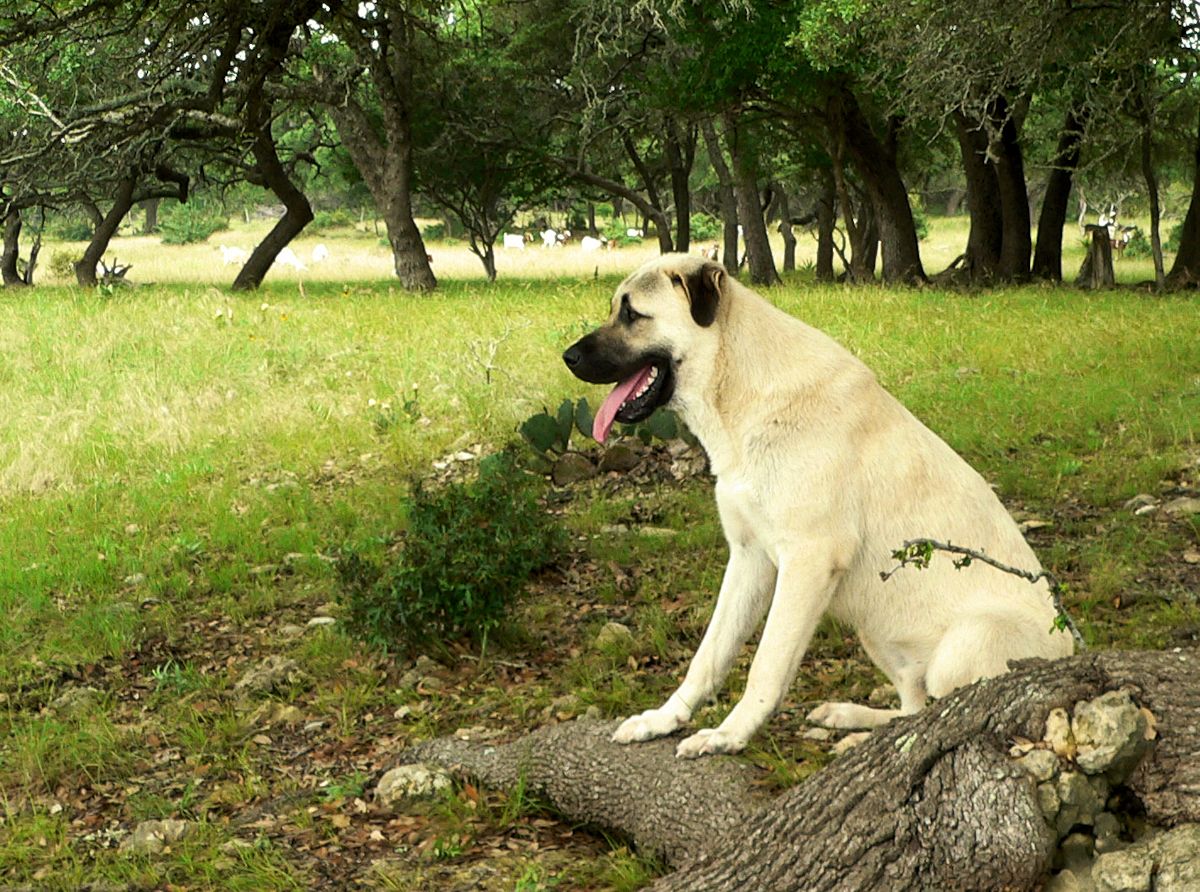 Nine month old Case (Lucky Hit Leydi Case) takes a break in the shade but is still acutely aware of his surroundings!  Nine month old Case (Lucky Hit Leydi Case) moves on again once the goats catch up to his resting spot.  Nine month old Case (Lucky Hit Leydi Case) |
Link to Lucky Hit Ranch Main Home Page
Link to Lucky Hit Ranch Anatolian Page